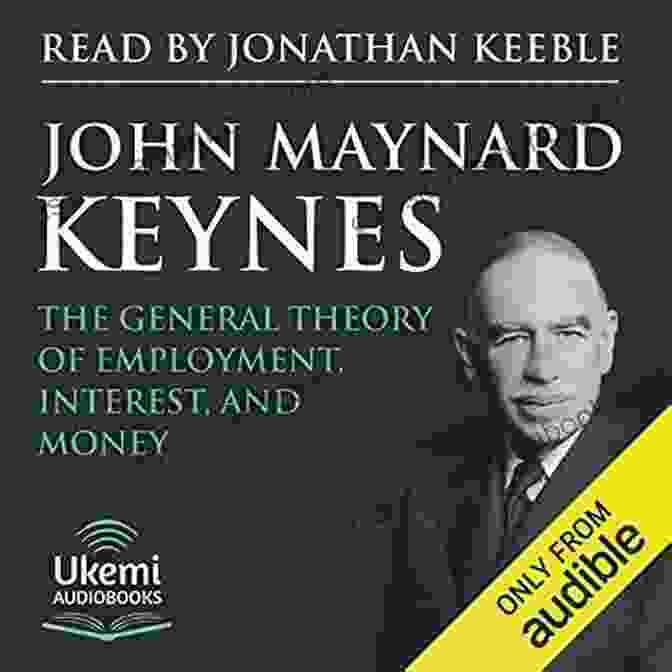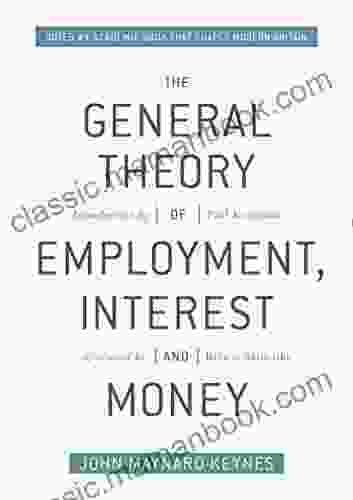The General Theory of Employment, Interest, and Money: A Comprehensive Guide


The General Theory of Employment, Interest, and Money (1936) by John Maynard Keynes is a seminal work in economic theory that revolutionized our understanding of macroeconomic phenomena. Breaking away from classical economic thought, Keynes proposed a new framework that focused on the role of aggregate demand, uncertainty, and liquidity preference in determining economic outcomes. This article aims to provide a comprehensive overview of the General Theory, its key concepts, and its lasting impact on economic theory and policy.
4.3 out of 5
| Language | : | English |
| File size | : | 8078 KB |
| Print length | : | 447 pages |
| Screen Reader | : | Supported |
| X-Ray for textbooks | : | Enabled |
The Keynesian Revolution
Keynesian economics is often characterized as a "revolution" in economic thought because it challenged the prevailing classical view that the economy tends towards full employment in the long run. Classical economists argued that wages and prices would adjust automatically to ensure that all available labor is employed. However, Keynes argued that this assumption was flawed, especially during periods of economic downturn.
Keynes introduced the concept of "effective demand," which he defined as the total amount of spending in an economy. He argued that effective demand is determined by a combination of factors, including consumer spending, investment, government spending, and net exports. When effective demand is low, the economy will experience unemployment and underutilization of resources.
Aggregate Demand and the Multiplier
One of the most important concepts in the General Theory is the aggregate demand curve. The aggregate demand curve shows the relationship between the overall price level in an economy and the quantity of goods and services demanded. Keynes argued that the aggregate demand curve is downward-sloping, meaning that as prices rise, the quantity demanded will decrease.
The multiplier effect is another key concept in Keynesian economics. The multiplier effect refers to the fact that an increase in spending will lead to a more than proportional increase in output. This is because the initial increase in spending will lead to an increase in income, which will then lead to further spending, and so on. The multiplier effect is a powerful tool that can be used to stimulate economic growth.
The Role of Uncertainty
Keynes also emphasized the role of uncertainty in economic decision-making. He argued that individuals and businesses are often uncertain about the future and that this uncertainty can lead them to reduce their spending and investment. This can create a vicious cycle of declining demand and unemployment.
Keynes proposed that the government could intervene in the economy to reduce uncertainty and stimulate demand. One way to do this is through fiscal policy, which involves changes in government spending and taxation. The government can increase spending or reduce taxes to increase aggregate demand and boost economic growth.
Liquidity Preference and the Interest Rate
Liquidity preference is another important concept in the General Theory. Liquidity preference refers to the desire of individuals and businesses to hold money rather than invest it in other assets. Keynes argued that liquidity preference increases as the interest rate rises. This is because holding money is more attractive when the interest rate is low.
The relationship between liquidity preference and the interest rate has important implications for monetary policy. Monetary policy refers to the use of interest rates and other tools to influence the money supply. Keynes argued that the central bank should not try to control the interest rate directly. Instead, the central bank should focus on controlling the money supply and letting the interest rate adjust to market forces.
The Legacy of the General Theory
The General Theory of Employment, Interest, and Money has had a profound impact on economic theory and policy. Keynesian economics has been a dominant force in economic thought since the 1930s and has been used to justify a wide range of government policies, including deficit spending, tax cuts, and monetary expansion.
Keynesian economics has also been criticized for its focus on short-term demand management and its neglect of long-run supply-side factors. However, there is no doubt that the General Theory is one of the most important works in economic history and that its insights continue to be relevant for understanding the workings of the economy.
The General Theory of Employment, Interest, and Money is a complex and nuanced work that has had a lasting impact on economic theory and policy. Keynes challenged the prevailing classical view of the economy and introduced new concepts such as aggregate demand, uncertainty, and liquidity preference. Keynesian economics has been used to justify a wide range of government policies and continues to be a dominant force in economic thought today.
4.3 out of 5
| Language | : | English |
| File size | : | 8078 KB |
| Print length | : | 447 pages |
| Screen Reader | : | Supported |
| X-Ray for textbooks | : | Enabled |
Do you want to contribute by writing guest posts on this blog?
Please contact us and send us a resume of previous articles that you have written.
 Top Book
Top Book Novel
Novel Fiction
Fiction Nonfiction
Nonfiction Literature
Literature Paperback
Paperback Hardcover
Hardcover E-book
E-book Audiobook
Audiobook Bestseller
Bestseller Classic
Classic Mystery
Mystery Thriller
Thriller Romance
Romance Fantasy
Fantasy Science Fiction
Science Fiction Biography
Biography Memoir
Memoir Autobiography
Autobiography Poetry
Poetry Drama
Drama Historical Fiction
Historical Fiction Self-help
Self-help Young Adult
Young Adult Childrens Books
Childrens Books Graphic Novel
Graphic Novel Anthology
Anthology Series
Series Encyclopedia
Encyclopedia Reference
Reference Guidebook
Guidebook Textbook
Textbook Workbook
Workbook Journal
Journal Diary
Diary Manuscript
Manuscript Folio
Folio Pulp Fiction
Pulp Fiction Short Stories
Short Stories Fairy Tales
Fairy Tales Fables
Fables Mythology
Mythology Philosophy
Philosophy Religion
Religion Spirituality
Spirituality Essays
Essays Critique
Critique Commentary
Commentary Glossary
Glossary Bibliography
Bibliography Index
Index Table of Contents
Table of Contents Preface
Preface Introduction
Introduction Foreword
Foreword Afterword
Afterword Appendices
Appendices Annotations
Annotations Footnotes
Footnotes Epilogue
Epilogue Prologue
Prologue Simon Beaufort
Simon Beaufort Jodi Thomas
Jodi Thomas Dick Russell
Dick Russell Dave Westerveld
Dave Westerveld Jane Farrow
Jane Farrow James Villas
James Villas Geoffrey C Fuller
Geoffrey C Fuller K Ramesh
K Ramesh L M Sanguinette
L M Sanguinette Lucy Coleman
Lucy Coleman Arushi Singh
Arushi Singh David Alton Hedges
David Alton Hedges Wesley Ellis
Wesley Ellis Shenika Paris
Shenika Paris Jp Roth
Jp Roth James Lee Burke
James Lee Burke Wolf Dieter Hellberg
Wolf Dieter Hellberg Morris G Davies
Morris G Davies Lynn Messing
Lynn Messing John Grace
John Grace
Light bulbAdvertise smarter! Our strategic ad space ensures maximum exposure. Reserve your spot today!

 F. Scott FitzgeraldHaikyuu!!, Vol. 18: Hope Is a Waxing Moon Review: An Enthralling Continuation...
F. Scott FitzgeraldHaikyuu!!, Vol. 18: Hope Is a Waxing Moon Review: An Enthralling Continuation... Chinua AchebeFollow ·10.6k
Chinua AchebeFollow ·10.6k Anton ChekhovFollow ·19.3k
Anton ChekhovFollow ·19.3k Brent FosterFollow ·5k
Brent FosterFollow ·5k Caleb CarterFollow ·18.9k
Caleb CarterFollow ·18.9k Danny SimmonsFollow ·19.6k
Danny SimmonsFollow ·19.6k Shane BlairFollow ·16.8k
Shane BlairFollow ·16.8k Gus HayesFollow ·18.7k
Gus HayesFollow ·18.7k Clayton HayesFollow ·9k
Clayton HayesFollow ·9k

 Bryan Gray
Bryan GrayCello Alternativo: Exploring Contemporary Pizzicato...
: Embracing the Avant-Garde Within...

 Victor Hugo
Victor HugoThe Social Revolution: Barry Libert's Vision for a More...
In a world where...

 Tony Carter
Tony CarterA Comprehensive Guide to Crafting Clear and Effective Job...
A job description is a critical tool...

 Deacon Bell
Deacon BellSelected Poems And Prose Lorenzo Da Ponte Italian Library
Lorenzo Da Ponte, born...

 Francisco Cox
Francisco CoxWhat You Need To Know About Opportunity Cost: A...
Opportunity cost is a fundamental concept...

 Bill Grant
Bill GrantWhy Our Kids With Behavioral Challenges Are Falling...
Every year,...
4.3 out of 5
| Language | : | English |
| File size | : | 8078 KB |
| Print length | : | 447 pages |
| Screen Reader | : | Supported |
| X-Ray for textbooks | : | Enabled |









